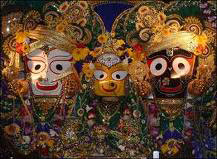| Rath Yatra |
 |
Rath Yatra [Rath - a chariot; Yatra - a journey], a major Hindu festival associated with Lord Jagannath is held at Puri in the state of Orissa, India.
Also known as Car festival, this spectacular chariot festival is celebrated in the month of Ashadha, on the second day of the lunar fortnight that falls during June-July. This festival is celebrated in the honor of Lord Jagannath (Krishna) who is believed to be an incarnation of Lord Vishnu. The festival commemorates Krishna's return to His home in Vrindavan after a long period of separation from the people there.
|
 |
The celebrated Rath-Yatra festival is said to have started in the time of Svarochisha Manu of the second manvantara and is predicted to continue until the end of the second half of Lord Brahma's lifetime. Even in the Valmiki Ramayana, it is related that when Lord Rama was getting ready to leave this world; he told Vibhishan, Ravana's younger brother to worship Lord Jagannath, the Lord of the Iksvaku dynasty in His absence. |
The Skanda Purana also fixes the date of the Rath-Yatra as the second day of the bright fortnight of the month of Ashadha, a day called Pushyami Nakshatra by astrological calculations. The Padma Purana describes that in Purushottama-kshetra, or Jagannath Puri, the supremely blissful Personality of Godhead pretends to be made of wood. In this way, although the Lord takes on what appears to be a material form, it is completely spiritual by the causeless mercy of the Lord for the conditioned souls who cannot perceive the transcendental domain of His.
On the day of the festival the wooden images of Krishna, Balrama and Subhadra are taken out in procession in three chariots to their summer temple for a week. The main chariot is 14 meters high and 10 meters square with 16 wheels. The actual construction of the carts begins two months before the festival day, on the third day of the bright fortnight of Vaisakha (April-May). More than 600 trees, or 400 cubic meters of wood, are needed for the construction, taken from the local forests along the banks of the Mahanadi River. Using the same simple tools and procedures as they have for the past hundreds of years, once the basic elements are made, such as the wheels, the actual construction begins only a few weeks before the festival.
|
 |
The ropes of the huge chariots are pulled by millions of devotees. In the ancient times, devotees would occasionally throw themselves in front of the chariot of Sri Jagannath, for it was believed that to be crushed to death under its sixteen wheels was to go straight to heaven. Since Sri Jagannath is a form of Vishnu and Sri Krishna, many of the rituals observed in Puri temple are associated with events in the life of Sri Krishna. Thus this annual car festival represents Sri Krishna's Journey from Gokul to Mathura. |
| This is the only day when devotees who are not allowed in the temple premises such as non-Hindus and foreigners, can get their glimpse of the deities. During the festival, devotees from all over India go to Puri with an earnest desire to touch the rope of the chariot. They consider this a pious deed and risk their lives in the huge crowd. The huge processions accompanying the chariots play devotional songs with drums, tambourines, etc. Children line the streets through which the chariot will pass and add to the mass chorus. Millions of devotees congregate at Puri for this annual event from all over the country and abroad. It is also telecast live on many Indian channels.
|
|
|
| Religions |
In India, religion is a way of life. It is an integral part of the entire Indian tradition. For the majority of Indians, religion permeates every aspect of life, from common-place daily chores to education and politics. Secular India is home to Hinduism, Islam, Christianity, Buddhism, Jainism, Sikhism and other innumerable religious traditions. Hinduism is the dominant faith, practised by over 80% of the population. Besides Hindus, Muslims are the most prominent religious group and are an integral part of Indian society. In fact India has the second largest population of Muslims in the world after Indonesia.
|
| Read more about Indian Religions |
|
|
